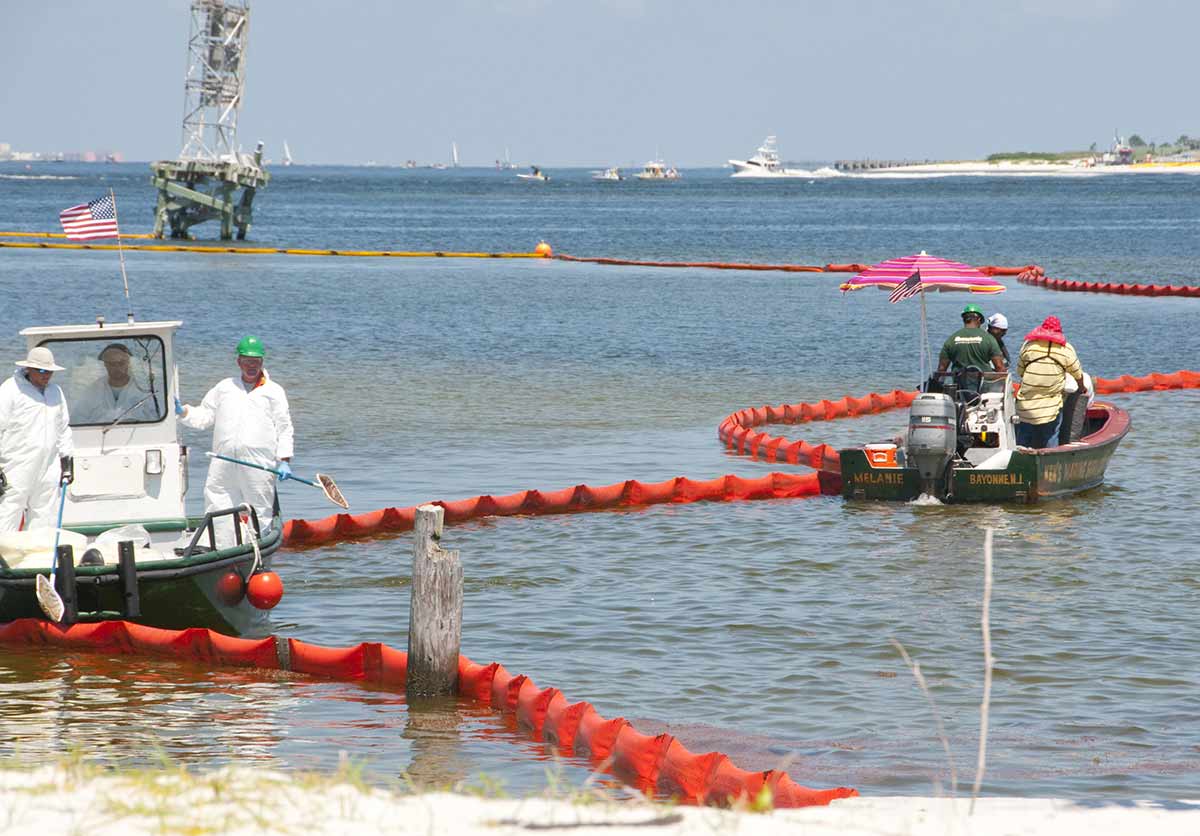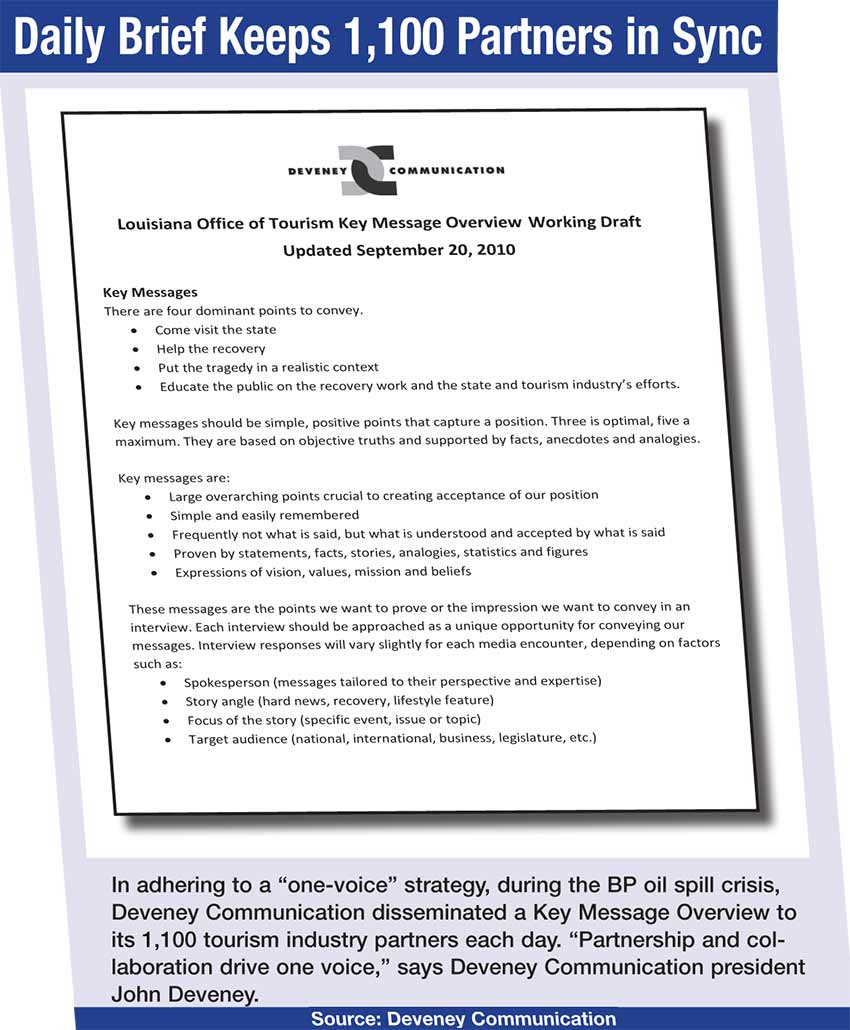 |
| After the BP oil disaster in April 2010, workers protected Louisiana’s shoreline, while Deveney Communication protected the state’s tourism industry from negative press and misperceptions. Photo courtesy Deveney Communication |
Organization: Louisiana Office of Tourism
Agency: Deveney Communication
Timeframe: June 2010 - May 2011
The April 20, 2010, explosion of the Deepwater Horizon oil rig in the Gulf of Mexico was tragic enough, killing 11 workers. But then, as oil gushed from the BP -owned well, an economic and environmental tragedy of epic proportions threatened to decimate Louisiana’s $9.4 billion tourism industry.
Thanks to an underwater camera that captured the gushing oil and a media that all but predicted catastrophe, “it was apparent that it was going to be a perception problem,” says Jim Hutchinson, assistant secretary of tourism at the Louisiana Office of Tourism (LOT).
On June 1, 2010, Deveney Communication, the New Orleans-based PR agency that has worked with LOT since 2005, got the call to lead the response. Within 24 hours, the agency developed a sweeping PR response campaign. The ultimate goal, says Deveney Communication president John Deveney, was to disseminate accurate information and proactively preserve the state’s tourism industry despite powerful imagery causing misperceptions. Specific objectives of the plan included:
1. Develop and implement the Office of Tourism’s response to the crisis
2. Engage and unify the tourism industry and its partners
3. Correct false perceptions that the state’s seafood was unsafe.
The PR effort would be huge, reaching more than 1,100 tourism industry partners and stakeholders on a daily basis.
 |
MEASURED RESPONSE
But first came the research. To start, Deveney and the Louisiana Office of Tourism reviewed their efforts from the previous six years. This included crisis campaigns around hurricanes Katrina and Rita. “We keyed in on our most successful efforts and studied why they were so successful,” says Deveney.
Media audits of oil spill coverage were conducted, as well as a comprehensive best practices assessment of the response strategies to the Exxon Valdez spill, the 9/11 attacks, Tennessee flooding and responses to Hurricane Katrina and the BP oil spill by surrounding states.
ONE VOICE
This research resulted in a 360-degree messaging strategy that connected the interests of Louisiana tourism to the demands of the media and the concerns of the most important publics. Central to this effort was the concept of “one voice,” which proved successful for Deveney and LOT during the Katrina crisis.
Having a single voice was critical because Deveney Communicaton was counting on more than 1,100 tourism-related partners to get consistent messaging out on a daily basis. “‘Here’s the status, what’s open and what’s not’—everyone had the most accurate, up-to-date information on hand,” says Deveney.
Thus, each weekday morning a Key Message Overview was sent to the partners, stakeholders and media spokespeople (see the snapshot of the overview). News clips were also monitored, catalogued and distributed to those industry partners and stakeholders daily.
In addition, Deveney Communication created an Experts Bureau of some 86 distinguished leaders who became valuable resources for the public and stakeholders. “It’s not often you have a pulmonologist available as an expert, but we did,” says Deveney.
Twenty strategic efforts were launched for a variety of existing and new events around the state. Among them:
â–¶ Shrimp and Petroleum Festival: Blog tracking, media relations and a communication audit were conducted around the 75th annual event. In addition, Deveney created and delivered a letter on behalf of the Lt. Governor Jay Dardenne to President Obama inviting him to attend the festival.
â–¶ Chefs Ashore: Deveney facilitated a partnership between Office of Tourism, the White House and Louisiana Seafood Marketing and Promotion Board for an elite group of chefs from around the country to learn about the testing and quality of Louisiana seafood.
FIGHTING FATIGUE
After the well was capped in July 2010 and the media had tapped out on cleanup stories, topic fatigue was setting in. In order to keep the messaging going, the agency turned to one of its lessons learned from studying PR around the Tennessee floods of May 2010: create milestone initiatives to keep the story front and center.
In that vein, Deveney Communication developed the “100+ reasons to visit Louisiana” campaign, which asked participants to share their favorite Louisiana experiences on social networking sites. Deveney Communication also kept the messaging momemtum going with three satellite media tours, including “Shrimp Ahoy” with chef Paul Prudhomme, advancing tourism and seafood safety messages via top media outlets from a shrimp dock in Dulac.
Deveney also executed four Media Familiarization Tours, which showcased the state’s offerings while demonstrating that its seafood was safe.
STAYING AFLOAT
Meanwhile, because of the scope of the campaign, Deveney Communication, which at the time was 15 people strong, was facing a challenge in trying to stay on point with other clients because of the manpower shift to the oil spill effort. Van Gallinghouse, senior VP at Deveney Communication, warns, “You have to be careful not to let the situation implode your firm.”
Hence, the agency informed other clients about the situation, then, they brought in freelance help—mainly administrative and media relations specialists to assist.
But the length of the BP engagement—one year—made things difficult, says Gallinghouse. “It was all hands on deck,” he says. Yet the work did get done, and Hutchinson says he was glad that Deveney Communication had the experience to handle such an event. “One of the wisest things we did was not pretend to be PR experts, “ says Hutchinson. “We gave Deveney enough rope to either hang themselves or be successful.”
Deveney has to think hard to come up with a component he would have added to the effort in retrospect. “If I had the chance to add an element, I would have provided formal media training for our 86 experts,” he says.
PROGRAM IMPACT
Here are some of the impacts of the campaign, relative to program objectives:
• A 1,097 to 1 return on investment (3,127% over objective) on the campaign.
• More than 667.3 million media impressions (1,026% over objective).
• Perceptions regarding the length of time Louisiana will be affected by the oil spill. were shortened significantly
• Oyster contamination concerns have declined significantly and false perceptions about Louisiana seafood in general have improved.
• Tourism numbers are trending up and are projected to surpass pre-Katrina numbers in both number of visitors and visitor spending by 2013.
Today, Hutchinson says while the Louisiana Office of Tourism has toned down its PR efforts, the seafood industry continues with programs on food safety. His one lesson learned? “Accuracy always, but speed is critical,” he says.
If leaders are hesitant to act on a crisis, concludes Hutchinson, LOT and Deveney’s work on the BP spill should be a useful incitement to quick action.
CONTACT:
Jim Hutchinson, [email protected]; John Deveney, [email protected]; Van Gallinghouse, [email protected]; John Doorley, [email protected].
